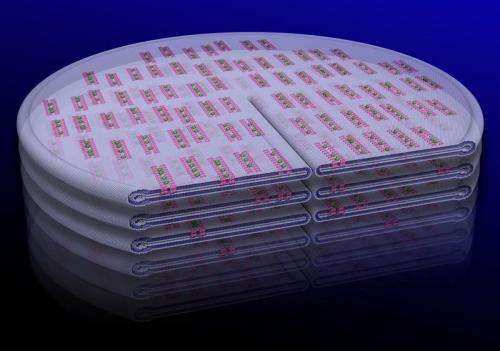Rhodopsin on track: Biological pigment aligns in double rows

Scientists from the caesar research center, an Institute of the Max Planck Society, have explained, with the help of electron microscopy, how the pigment rhodopsin is arranged in the rod cells of the retina. This question has long been subject of a heated scientific debate. The findings have been published in the scientific journal Structure. Future research on diseases causing blindness will be facilitated by this discovery.
Seeing starts in the rods and cones, two different types of sensory cells in the retina of the eye. The rods are responsible for dark vision and are particularly sensitive to light as a result. A single photon activates the pigment rhodopsin and initiates the process of vision. The rhodopsin molecules are found in flat membrane disks in the outer segment of photoreceptors. The biochemical processes on which vision is based have been known for many years: rhodopsin triggers a highly-reinforced cascade of enzymatic reactions which give rise to electrical excitation. However, it was unclear up to now how the rhodopsin is arranged in these disks. For example, scientists debated whether rhodopsin arises as dimers, or whether the rhodopsin molecules wander around freely on the discs and thus encounter their interaction partners at random – like billiard balls following a wild hit with the cue.
Working in cooperation with Ashraf Al-Amoudi from the German Center for Neurodegenerative Diseases (DZNE), the researchers from the caesar research center used cryo-electron microscopy to examine the arrangement of rhodopsin in the rods of mice. This method involves the vitrification of the samples by shock-freezing, which conserves their natural structure. The actual examination of the sample is carried out using a cryo-transmission electron microscope which provides the resolution necessary to make individual molecules visible.
The team of scientists headed by Benjamin Kaupp and Ashraf Al-Amoudi succeeded in demonstrating that the rhodopsin molecules arise as dimers. In addition, the rhodopsin shows a supramolecular structure: the dimers are arranged in rows consisting of around 50 molecules. Two rows align to form double rows - like railway tracks. All rows are parallel in their arrangement.
The physiological function of such a regular arrangement is currently unclear. It is possible that the double rows form a platform, on which other molecules that participate in the electrical signal transformation, are also arranged regularly. The parallel arrangement could possibly explain polarisation vision, which is used by some vertebrates – for example amphibians and birds – to orient themselves in their environment. Unlike the polarisation vision of insects, the corresponding mechanisms in vertebrates are still inadequately understood. Whether this capacity also exists in mammals remains a matter of dispute. The results on the mouse model will lead to further studies.
More information: Gunkel, M., Schöneberg, J., Alkhaldi, W., Irsen, S., Noé, F., Kaupp, U.B. & Al-Amoudi, A. "Higher-order architecture of rhodopsin in intact photoreceptors and its implication for phototransduction kinetics." Structure, doi: dx.doi.org/10.1016/j.str.2015.01.0
Journal information: Structure
Provided by Max Planck Society



















